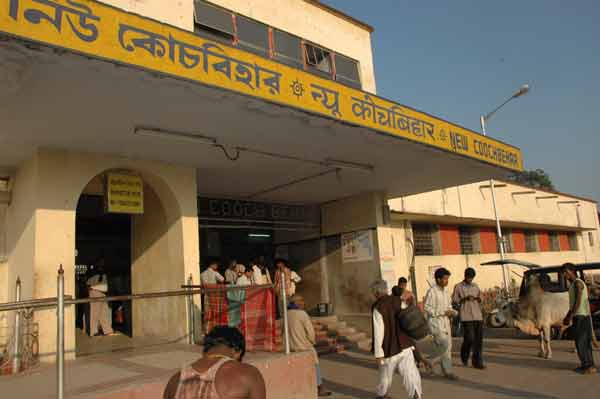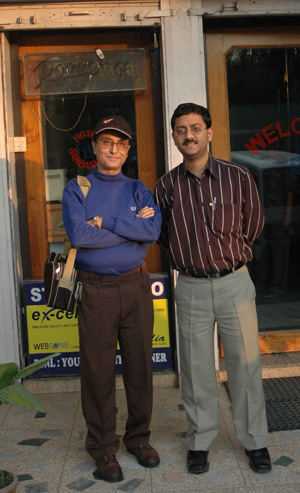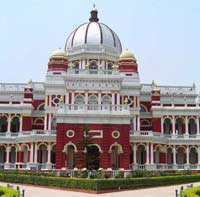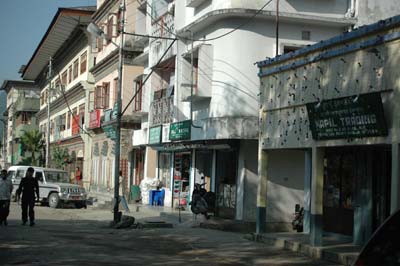SWEDISH SOUTH ASIAN STUDIES NETWORK
Journey from Guwahati to Phuentsholing, Saturday 26 November
 It
doesn’t come as a complete surprise, but as the train leaves Guwahati
railway station heading westward, we travel along miles of slum dwellings,
small miserable shacks and an incredible dirty surrounding with litter
everywhere. This is also India in the era of IT and world economic and
political aspirations!
It
doesn’t come as a complete surprise, but as the train leaves Guwahati
railway station heading westward, we travel along miles of slum dwellings,
small miserable shacks and an incredible dirty surrounding with litter
everywhere. This is also India in the era of IT and world economic and
political aspirations!
This is, of course, the real challenge: when will there be a progressive
linkage between the dynamic service and science-based future economy with
its enormous global potential and that other half still trailing in such
a misery?
On the train itself, a stream of beggars appears, all of them physically
handicapped. There is no way you can avoid or escape and we have to part
with coins and small notes. The heart simply caves in as we sit comfortable
in our spacious AC two-tier compartment.
 We pass
the mighty Brahmaputra and surrounded by green mountains we move into
the rich green flatlands of its basin, and after a few hours we leave
Assam and once again enter the state of West Bengal.
We pass
the mighty Brahmaputra and surrounded by green mountains we move into
the rich green flatlands of its basin, and after a few hours we leave
Assam and once again enter the state of West Bengal.
 At 3 o’clock in the afternoon, one hour late, we arrived in the
North Bengal town of Cooch Behar
– till 1949 the capital of the princely state with the same name.
The Maharaja of Cooch Behar ceded his country to the Dominion of India
only on the 28th of August 1949, the so-called Cooch Behar Merger Agreement
(read
details about the agreement). Still the city is dominated by the old
Royal Palace, called Rajbari (see photo to the left).
At 3 o’clock in the afternoon, one hour late, we arrived in the
North Bengal town of Cooch Behar
– till 1949 the capital of the princely state with the same name.
The Maharaja of Cooch Behar ceded his country to the Dominion of India
only on the 28th of August 1949, the so-called Cooch Behar Merger Agreement
(read
details about the agreement). Still the city is dominated by the old
Royal Palace, called Rajbari (see photo to the left).
Unfortunately we did not have any time to look around in this interesting
town, as we had to proceed to the Bhutanese border before evening. We
were met at the railway station by Dr. Soumyajit
Samanta, an acquaintance
from our visit to North Bengal University in Siliguri, a week before
(see the report), and his friend Debasish
Bhowmick, called Debu. They
had promised to take us to the border town of Jaygaon/Phuentsholing by
car, and after a quick late lunch at Sarbashree Lodge we departed from
Cooch Behar with Debu’s
Hyundai car and set out northwards in the direction of the Bhutanese
border.
At first we passed villages and small farmsteads somewhat elevated on
clay platforms to avoid floods during the monsoons, a phenomenon so typical
of Bengal. Flat lands, cattle, green plots with a variety of crops. After
a while we reached the highway going through the thick forest jungle.
This was Doars, the rolling landscape of North Bengal stretching all the
way up to the foot of the Himalayan mountains, a region full of tea plantations
and forests with leopards and other wild animals. As it started to become
dark outside Debu drove fast, being a bit apprehensive about parked vehicles
– this area is infested with thugs, he said.
The journey should have taken a couple of hours, but due to absence of
proper road signs we missed the turning from the Highway towards Jaygaon,
drove much too far and had to return and search again for a turning. It
was 7 P.M. when we finally drove into the twin towns of Jaygaon (on the
Indian side of the border) and Phuentsholing (on the Bhutanese side).
In fact the two towns are totally built together, and people cross the
open border without any control. Without realising it we did the same.
When parking the car outside a shop complex it turned out we have already
passed the imposing gate and entered Bhutan without passing any passport
control or customs office! The registration bureau closes already at 5
o’clock.
 This
created a problem, because we thought that we were going to be met by
our Bhutanese guide, arranged for us through the Centre for Bhutan Studies
(CBS) in Thimphu, right at the border. But how to find him now without
knowing neither his name nor his telephone number? What should we do?
This was the first mistake in our otherwise elaborate planning of the
journey (it later turns out we had failed to receive an e-mail from CBS
giving the contact information about the guide).
This
created a problem, because we thought that we were going to be met by
our Bhutanese guide, arranged for us through the Centre for Bhutan Studies
(CBS) in Thimphu, right at the border. But how to find him now without
knowing neither his name nor his telephone number? What should we do?
This was the first mistake in our otherwise elaborate planning of the
journey (it later turns out we had failed to receive an e-mail from CBS
giving the contact information about the guide).
The problem was however solved with a phone call to Thimphu, yes fortunately
there were still people working at CBS, and through them we got hold of
our host, Dr. Karma Galay. He informed us about which hotel we are booked
into, and he gave the mobile number to our guide, Mr. Samdruk.
 Hotel
Druk is the nice place where we are going to stay, and we get installed
in this already classic establishment. We called Mr. Samdruk (photo
to the right) and he was with us in few minutes, and we got the schedules
already prepared for our stay in Bhutan. Since we missed the border control,
he said, we must go back to Jaygaon (India) next morning and get our emigration
stamps, before leaving for Thimphu with a brand new Hyundai Jeep.
Hotel
Druk is the nice place where we are going to stay, and we get installed
in this already classic establishment. We called Mr. Samdruk (photo
to the right) and he was with us in few minutes, and we got the schedules
already prepared for our stay in Bhutan. Since we missed the border control,
he said, we must go back to Jaygaon (India) next morning and get our emigration
stamps, before leaving for Thimphu with a brand new Hyundai Jeep.
We spent the evening at Druk Hotel, eating late supper with our Indian
friends, and having a typical Bengali wide-ranging intellectual discussion
on issues as varied as Harold Pinter’s 2005 Nobel prize, Bengali
literature, Alexander the Great, why there will be poor people in India
even in 2025… Then we had a bidding farewell, warmly thanking them
for bringing us safely here in the darkness amidst thugs and other dangers.
A few words of eternal wisdom from Lord Buddha and a long sleep. We were
now inside Druk Yul – the Kingdom of the Thunder Dragon.
SASNET - Swedish South Asian Studies Network/Lund
University
Address: Scheelevägen 15 D, SE-223 70 Lund, Sweden
Phone: +46 46 222 73 40
Webmaster: Lars Eklund
Last updated
2006-02-24
